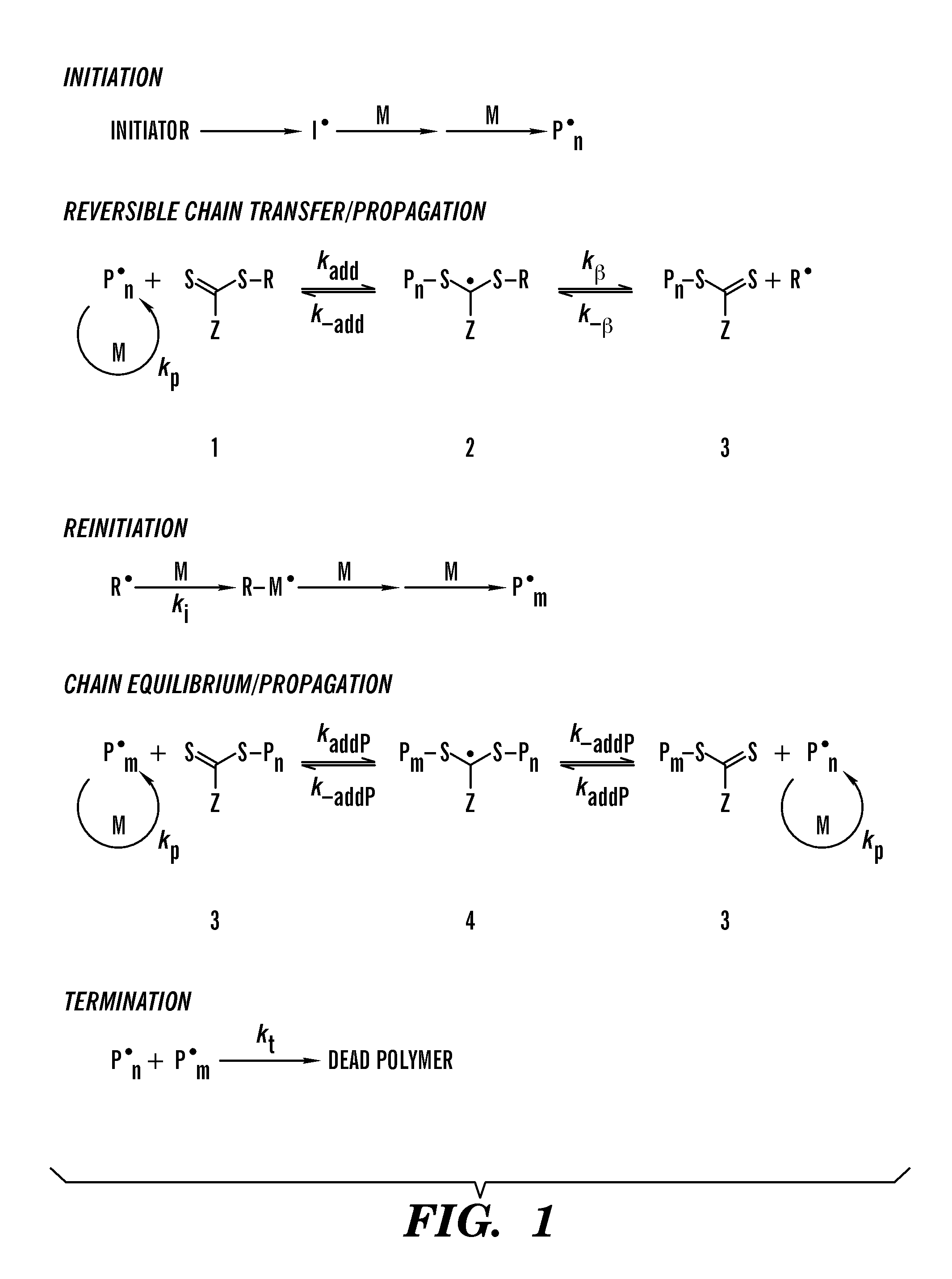Thermoplastic elastomers via reversible addition-fragmentation chain transfer polymerization of triglycerides
a technology of thermoplastic elastomers and chain transfer polymers, which is applied in the direction of vinyl aromatic copolymer adhesives, adhesive types, coatings, etc., can solve the problems of uncontrollable chain branching and crosslinking, shortening of sbs polymers for asphalt industry, etc., to promote the incorporation of cta fragments into the polymer backbone, and increase the cost of vegetable oil monomers. , the effect of increasing the cos
- Summary
- Abstract
- Description
- Claims
- Application Information
AI Technical Summary
Benefits of technology
Problems solved by technology
Method used
Image
Examples
example 1
Synthesis of Poly(Styrene) (PS), Poly(Acrylated Epoxidized Soybean Oil) (PAESO), Poly(Acrylated Epoxidized Soybean Oil-Block-Styrene) (PAESO-PS), and Poly(Styrene-Block-Acrylated Epoxidized Soybean Oil-Block-Styrene) (PS-PAESO-PS) via Reversible Addition-Fragmentation Chain Transfer Polymerization (RAFT)
[0144]Acrylated Epoxidized Soy Bean Oil (AESO) was purchased from Fisher Scientific and was used as received. High-performance liquid chromatography (HPLC)-grade toluene was purchased from Fisher Scientific and used without further purification. Styrene was purchased from Fisher Scientific and purified over basic alumina followed by three freeze-pump-thaw cycles. RAFT synthesis was performed in a similar manner to the procedure described in Moad et al., “Living Radical Polymerization by the Raft Process—a First Update,”Australian Journal of Chemistry 59: 669-92 (2006); Moad et al., “Living Radical Polymerization by the Raft Process—a Second Update,”Australian Journal of Chemistry 62(...
example 2
Synthesis and Characterization of PAESO, PAESO-PS, PS-PAESO, and PS-PAESO-PS via RAFT Polymerization
[0154]Materials, synthetic procedures, and characterization experimentations for PAESO, PAESO-PS, PS-PAESO, and PS-AESO-PS via RAFT polymerization have been described in Example 1. The polymers synthesized and subsequently used for characterizations are listed in Table 2. The results are shown in FIGS. 16-18.
TABLE 2List of polymers used for characterizationsSample NameM.W.aPDIb% Styc1std2ndePAESO29,5001.390——PAESO-PS48,1501.590.3918,650—PS-PAESO40,9801.340.3313,900—PS-PAESO-PS #153,3001.840.4913,90012,200aTotal molecular weight of BCPbPolydispersitycPercent styrene in BCPdMolecular weight of styrene in first blockeMolecular weight of styrene in second block
example 3
Synthesis and Characterization of Poly(Acrylated Epoxidized Corn Oil) (PAECO) Homopolymers Via RAFT Polymerization
[0155]Materials, synthetic procedures, and characterization experimentations for PAECO homopolymer via RAFT polymerization are the same as those described in Example 1, except that the monomer used in the RAFT polymerization in this example is corn oil rather than soybean oil. The results are shown in FIG. 19-20.
PUM
| Property | Measurement | Unit |
|---|---|---|
| molecular weight | aaaaa | aaaaa |
| glass transition temperature | aaaaa | aaaaa |
| Tg | aaaaa | aaaaa |
Abstract
Description
Claims
Application Information
 Login to View More
Login to View More - R&D
- Intellectual Property
- Life Sciences
- Materials
- Tech Scout
- Unparalleled Data Quality
- Higher Quality Content
- 60% Fewer Hallucinations
Browse by: Latest US Patents, China's latest patents, Technical Efficacy Thesaurus, Application Domain, Technology Topic, Popular Technical Reports.
© 2025 PatSnap. All rights reserved.Legal|Privacy policy|Modern Slavery Act Transparency Statement|Sitemap|About US| Contact US: help@patsnap.com



